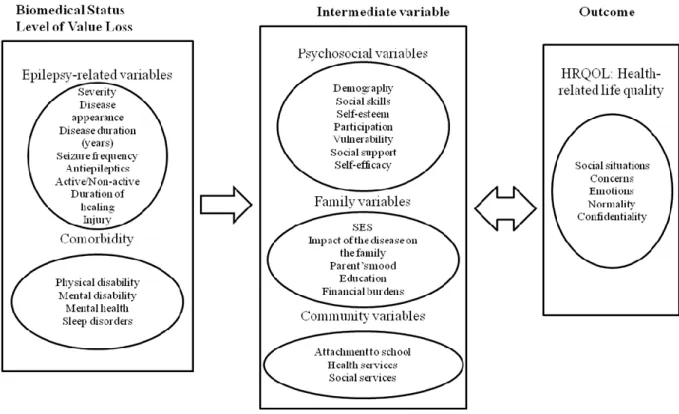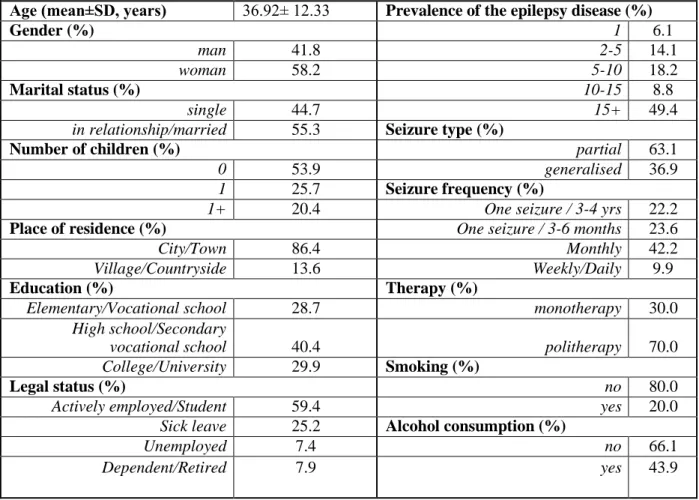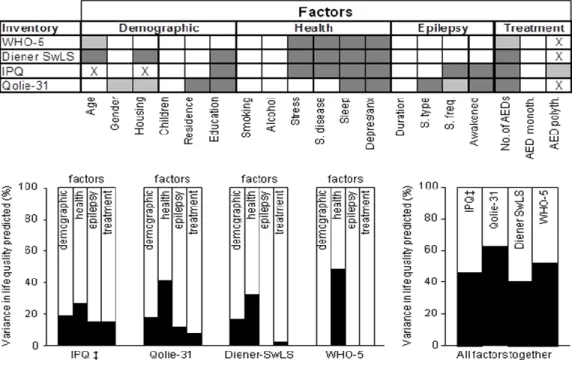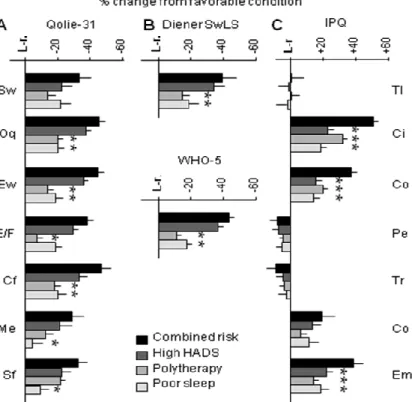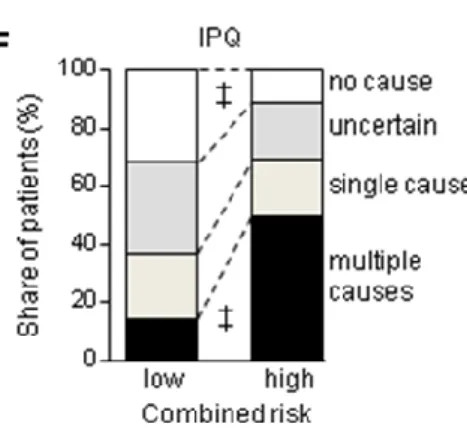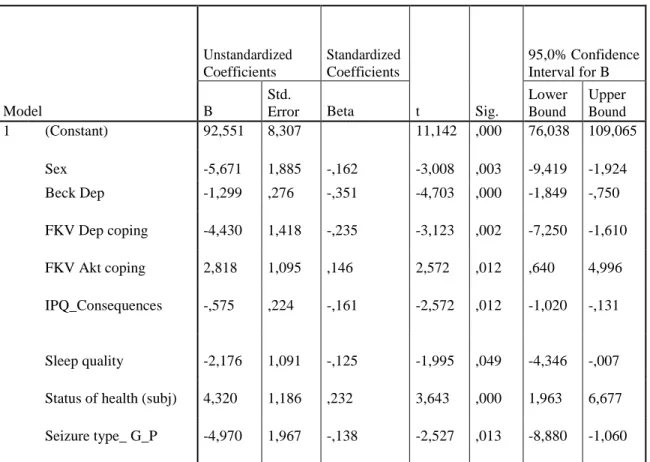Psychosocial and family functionality investigation of patients living with epilepsy
PhD. thesis
Daniella Kováts
School of PhD Studies, Semmelweis University School of Mental Health Sciences
Supervisor: Dr. Tamás Kurimay, Ph.D.
Opponents: Dr. Éva Jekkel, Ph.D.
Dr. Rita Jakus, Ph.D.
President of the final exam committee: Dr. Ferenc Túry, Ph.D.
Members of the final exam committee: Dr. Anna Szűcs, Ph.D.
Dr. Szabolcs Török, Ph.D.
Budapest
2018
1. Introduction
1.1 Life quality research among epileptic patients
The goal of life quality research among epileptic patients is not to investigate the efficiency of specific medical and surgical interventions, which are usually measured by focussing on disease variables such as the type of seizure, seizure frequencies or the level of neurotoxicity depending on the applied antiepileptics. In fact, life quality tests aim to assess how individual disease characteristics affect health condition, and which variables play a particularly important role in the perception of the life quality in the subjective judgement of the individual. Consequently, these studies focus on personal and environmental factors, besides examining the health condition.
Health-related life quality has been defined in numerous ways. The present work uses the Testa and Simonson’s definition which describes the quality of life as the patient’s subjective perception of several areas of life influenced by a chronic illness (in this case by the epilepsy disease) and its treatment respectively. The present PhD study applies the theoretical framework of the quality of life assessment described in the work of Raeburn and Rootman (2007) and Lach et al. (2006) respectively. Raeburn and Rootman outline the role of the personal and environmental variables which determine the quality of life in their theoretical framework. Meanwhile, Lach et al. (2006) emphasized the importance of interpersonal relationships and social environment in their model. Based on the two models outlined above, the theoretical concept of the present study has been formulated in the following way (Figure 1).
Figure 1: Groups of variables affecting health-related quality of life (Lach et al., 2006)
The model originally shows the factors influencing the life quality of children with chronic illnesses, in which the authors clearly distinguished specific variables related to epilepsy and comorbid diseases respectively, psychosocial variables, family variables, community variables, and the dimensions of disease-related life quality.
1.2 Factors influencing the quality of life of epileptic patients
Epilepsy is a neurological disorder, which symptoms are relatively well-managed, but cannot be eliminated and can greatly influence the patients’ life quality, everyday life and psychosocial condition (Singh and Trevick, 2016, Taylor et al., 2011). Identifying the factors which influence epilepsy is necessary for the proper management of the disease. There is a wide range of such factors, including sociodemographic ones (e.g. age, gender, education) (Buck D. et al., 1999; Djibouti and Shakarishvili, 2003; Giovagnoli et al., 2006), somatic and comorbid psychiatric disorders which affect the general health condition (Cramer et al., 2003;
Leidy et al., 1999), and disease variables that are related to the seizure severity, frequency and symptoms of the given disease, as well as therapeutic variables (AED side effects) of epileptic seizures. (Amir et al., 1999; Guekht et al., 2007; Kwan et al., 2009) (ILAE, 2003).
Among patients living with epilepsy, the prevalence of psychosocial problems is significantly higher, than sine morbo control groups. The ILAE (International League Against Epilepsy) highlights that these psychosocial obstacles are mostly related to employment and interpersonal relations (ILAE, 2003). The psychosocial health condition of epileptic patients is worse than in the normal population. In the light of this, the comprehensive knowledge of psychosocial aspects plays an important role in the psychodiagnostic, psychotherapeutic and rehabilitation work of doctors and psychologists.
2. Goals
The primary objective of the present dissertation was to investigate the psychosocial condition and life quality of epileptic patients and the functioning of families struggling with this disease.
2.1 Hypotheses of the research
Hypothesis 1: The factors influencing quality of life (measured by Qolie-31), will be in line with the results of international research, i.e. gender, residence, education, the degree of anxiety and depression, sleeping problems, seizure type and frequency, and the type of drug therapy will prove decisive. In relation to gender, women show a lower quality of life.
Hypothesis 2: The thesis assumes that the examined influencing factors (socio-demography-, general-health variables; epilepsy-specific and treatment specific factors) will most probably affect the Qolie-31 total score the most amongst the four measuring instruments.
Hypothesis 3: By forming high and low risk groups, risk factors have a negative impact on quality of life and by the separation of this groups differences will be seen in subjective illness perception scales, including the reasons of the disease. The high risk group will give a significantly higher score in general.
Hypothesis 4: The author presumes that the degree of comorbid anxiety and depression in the examined sample will be in line with the results of international investigations. Of the coping strategies the depressive coping strategy, religious coping and trivialisation as well as the measured constructs of subjective perception the most important is the degree of emotional control, consequences, and illness coherence, the search for the meaning of the disease, will prove the most significant.
Hypothesis 5: Focussing on coping and subjective disease variables, the factors that determine life quality the most are the following ones: depression, anxiety and sleep regarding health condition; sex and education concerning sociodemographic factors; as well as the perception of the consequences, the understanding of the illness and the level of emotional control among the factors of illness perception.
Hypothesis 6: In the comparative study of epileptic and control families, the study expects to find significant differences among study patients and family members concerning the psychosocial scales, as well as the social support and family functions scales. We are more likely to expect worse family functioning for families of epileptic patients.
Hypothesis 7: The author assumes that study patients with epilepsy and their family members will probably show significant differences in the evaluation of psychosocial status and family functioning. I assume that there will be significant differences between the epileptic patients living in their original and new families both on the psychosocial, as well as on the the family functioning scales.
Hypothesis 8: The thesis presumes that life satisfaction and general life quality in epileptic individuals will be mainly determined by variables related to the disease, comorbid conditions and their consequences, as well as to more extreme variables of family functioning; while concerning family members, the research is expected to point out the importance of the family's general functioning, communication, behaviour control, and social support.
3. Methods
3.1 Study patients
In a cross-sectional study, the data of 170 patients with epilepsy from the National Institute of Clinical Neurosciences (national centre), St. John's Hospital (regional centre) and two private health care centres were recorded. Data was collected between 09/01/2011 and 30/05/2015.
The selection criteria of the study patients were the followings:
- epilepsy disease diagnosed by a neuorologist at least a year ago;
- 18 to 70 years of age;
- completed elementary school (at least 8 years of education);
- regular participation in periodic medical check-ups;
- no surgery concluded;
- control of the disease with antiepileptics;
- the patient's informed consent to participation in the study.
Exclusion criteria:
- a serious, chronic illness besides the epilepsy;
- required hospitalisation;
- existence of alcohol or drug addiction;
- existence of PNES (Psychogenic Non-Epileptic Disease).
In the cross-sectional examination of family functioning, a further study of the previously tested 170 epileptic patients was performed. 42 persons were selected from them who lived in a social situation, not as a single person. In the original sample of 170 persons, 76 and 94 individuals were single and lived in a social setting respectively, which corresponded to 44.7 percent and 55.3 percent of the sample respectively. The availability and consent of the patients determined the selected 42 persons who participated in the study with the involvement of their family members. Data was collected between 09/01/2011 and 30/05/2015. The criteria for inclusion in and exclusion from the study were similar to the previous two investigations, while an additional criterion was to stablish ruling out single patients, and involving only those who live in social relationship.
The study was performed with the permission of the Scientific and Research Committee of the Hungarian Medical Research Council (ETT-TUKEB). (ETT-TUKEB, Budapest, Hungary, registration number 25962-0 / 2010 / 1018EKU (1010 / PI / 10, 24.01.2011) and was in line with the Helsinki Declaration and the applicable Hungarian legislation regarding the protection of human beings and medical data. All patients participated in the study after having filled in a consent form.
3.2 Data collection methods
Study patients were asked to fill in a Psychosocial Health Check Battery which allowed collecting sociodemographic data such as age, gender, marital status, number of children, place of residence, education, smoking and drinking habits, sleep patterns (both the quality and quantity of sleep), and whether they were under stress in the previous two years. In addition, specific disease variables associated with the disease were investigated, including the frequency of seizures and the occurrence of nocturnal awakenings due to the seizures.
Regarding disease variables, data was collected about the duration of epilepsy disease, the
types of the seizures, and the applied antiepileptics based on outpatient medical records.
Besides providing general sociodemographic data, patients had to complete the psychometric tests of the Psychosocial Health Check Battery, which aimed to assess the psychosocial condition. In the Family Functioning Investigation, sociodemographic data (such as age, gender, marital status, number of children, place of residence, education, current legal status, workplace, the ability to handle given situations at work and the eventual fear of losing job) were collected by applying a Family Functioning Test Battery. In addition, smoking and drinking habits, eventual stress over the last two years, and regular physical activities were surveyed. Furthermore, study patients were asked to provide information about health condition and health problems occurring over the previous 5 years. Finally, the individuals’
overall life quality in general and over the previous month was surveyed. In addition to the general sociodemographic data, patients were asked to complete the psychological tests of the Family Functioning Test Battery.
3.3 The psychometric instruments used in the study
Beck Depression Scale (BDI): The Beck Depression Scale (Beck 1961; Beck, 1972; Beck, 1988) is a self-completion questionnaire to measure the symptoms of depression. The present study examined the symptoms of depression with the 9-item and a 4-point Likert scale (Kopp et al., 1990; Kopp et al., 2006; Rózsa, 2009).
Caldwell's Support Dimension Scale (SDS): The Caldwell SDS scale was created in 1987 and translated into Hungarian by Kopp and Skrabski in 1992. In the test, study patients should name persons who provide support to them in difficult situations and at the same time indicate to what extent they receive this support (Szádóczky et al., 2004; Skrabski et al., 2005).
Diener's Satisfaction with Life Scale (SWLS): The self-completion questionnaire consisting of five items was developed by Diener et al. in 1985 to measure life satisfaction and subjective well-being (Martos et al., 2014).
FACES-IV (OCST): The Olson Family Test measures the dimensions of the Circumplex model designed by the same author to assess family cohesion and adaptivity (Kissgyörgyné et al., 2006). The adaptive functioning of family cohesion is represented by the "Connected"
subscale ranging from "Disengaged" to "Enmeshed" at its extreme endpoints. The central, adaptive element of the flexibility dimension is represented by the "Flexible" subscale ranging from "Rigid" to "Chaotic" subscales as endpoints. The six structural subscales are
complemented by two additional ones, namely the “Family Communication” subscale measuring communication in the family and the "Family Satisfaction" scale, which assesses the degree of family satisfaction.
Family Assessment Device (FAD): The FAD scale was developed by Epstein et al. in 1978 (Epstein et al., 1978). The FAD aims at measuring the family functioning described by the Family MC Master model. One scale measures General functioning, while the other six are Problem Solving, Communication, Roles, Affective Responsiveness, Affective Involvement and Behaviour Control.
FKV-LIS Fragebogen zur Krankheitsverarbeitung: A Freiburger Fragebogen zur Krankheitsverarbeitung (FKV-LIS) survey developed by Fritz Muthny and validated by Tiringer et al. in 2011 is suitable to measure and study various disease-related coping strategies, like depressive, distractive, active, spiritual/religious and trivialising modes of coping with the disease (Tiringer et al., 2011).
Hospital Anxiety and Depression Scale (HADS) (Zigmond & Snaith, 1983): Each of the seven items measure anxiety (HADS-A) and depression (HADS-D) respectively. Patients can fill in the test with respective on their last week. (Muszbek et al., 2006)
Illness Perception Questionnaire Revised (IPQ-R): The questionnaire was developed by Moss-Morris in 2002 (Moss-Morris et al., 2002) to evaluate subjective illness perception of the disease along 7 dimensions, such as timeline (measures if the disease is chronic), timeline cyclical (analyses the cyclical nature of the disease), consequences (the consequences and impact of the disease on the patient's life), personal control (the perception of disease control), treatment control (the perception of the treatment control of the disease), illness coherence (the subjective understanding of the disease) and emotional representations (the emotions aroused by the disease). The questionnaire also examines the diseases attributed to the patients (Reinhardt, 2007).
Quality of Life of Epilepsy (Qolie-31): The test for health-related quality of life measurement has been developed specifically for adult epileptic patients (Cramer et al., 1998). The test focuses on epilepsy-specific factors affecting the quality of life and includes 7 subscales, namely overall quality of life, seizure worry, emotional well-being, cognitive function, energy/fatigue, medication effects, and social function (Lám et al., 2001).
Rosenberg's Self-Esteem Scale (RSESH): The self-completion questionnaire developed by Rosenberg (1965) measures the constructs of self-assessment. Its 10-item version is suitable to assess general self-esteem on a 4-point Likert scale (Sallay et al., 2014).
Schwarzer's Self-Efficacy Scale (GSE): The Hungarian version of the self-efficacy questionnaire developed by Schwarzer (1992, 1993) is a shortened 4-item scale which can be used for measuring self-efficacy (Kopp 1993, Rózsa et al. 2003).
WHO Well-Being Index (WHO-5): This quality of life assurance tool was developed by the WHO (World Health Organization) in 1993. The present study applied its shortened Hungarian version (Bech P, 2004; Rózsa et al., 2003).
4. Results
4.1 The application of the four psychiatric measuring instruments in the study of the life quality of epileptic patients
Table 1: The sociodemographic data of the study patients
Age (mean±SD, years) 36.92± 12.33 Prevalence of the epilepsy disease (%)
Gender (%) 1 6.1
man 41.8 2-5 14.1
woman 58.2 5-10 18.2
Marital status (%) 10-15 8.8
single 44.7 15+ 49.4
in relationship/married 55.3 Seizure type (%)
Number of children (%) partial 63.1
0 53.9 generalised 36.9
1 25.7 Seizure frequency (%)
1+ 20.4 One seizure / 3-4 yrs 22.2
Place of residence (%) One seizure / 3-6 months 23.6
City/Town 86.4 Monthly 42.2
Village/Countryside 13.6 Weekly/Daily 9.9
Education (%) Therapy (%)
Elementary/Vocational school 28.7 monotherapy 30.0
High school/Secondary
vocational school 40.4 politherapy 70.0
College/University 29.9 Smoking (%)
Legal status (%) no 80.0
Actively employed/Student 59.4 yes 20.0
Sick leave 25.2 Alcohol consumption (%)
Unemployed 7.4 no 66.1
Dependent/Retired 7.9 yes 43.9
Figure 2: Correlations between Qolie-31 and the psychosocial measuring instruments.
Figure 3: Multiple regression analysis results with four measuring instruments
Figure 3 shows the influence of each variable on the measuring instruments (upper figure), the variance of the factors influencing each instrument (lower figure, left) and finally the variance of all significant influencing factors in the light of the individual measuring instruments.
In order to further examine the different influencing factors, a low risk group of patients with no sleep problems, low HADS scores and applied monotherapy was set up (N=28). At the same time, a high risk group with opposite characteristics was established as well (N=27).
The three key factors (sleep problems, HADS and AED therapy) were linked to all four measuring instruments. In the next step, the percentage differences of the low and high risk groups were compared by examining the impact of each risk factor and their combinations as well.
Figure 4: The individual risk factors and their combined effect on the measuring instruments The influence of epilepsy-specific factors shows a similar course. (Figure 5.)
Figure 5: Epilepsy-specific factors and their combined effect on measuring devices
In addition to the above mentioned variables, IPQ measures the underlying causes of illness, the reasons which patients subjectively consider the cause of their illness. Based on these criteria, the low-risk group (low level of seizure frequencies, no nocturnal awakening caused by the seizure, monotherapy, N=26) with the high-risk group (frequent seizures, nocturnal awakening due to the seizures, politerapy, N=35). There are significant differences between the results of the two groups, as the members of the high-risk group reached significantly higher scores in general (the average score calculated for all possible causes of the low-risk group was 1.7 ± 0.08 points, while the high-risk group reached 2.04 ± 0.15, where F = 4.82, p
<0.05). Meanwhile, the high-risk group recorded significantly higher scores for stress, poor medical care, emotional status, and accidents as a consequence of the disorder than the low- risk group (the individual scores in order: 2.63 ± 0.24 vs. 3.29 ± 0.30, 1.34 ± 0.12 vs. 2.31 ± 0.32, 1.97 ± 0.20 vs. 2.85 ± 0.33 and 1.60 ± 0.20 vs. 2.58 ± 0.35 (low vs. high risk = 4.98; p
<0.05; F disease reasons = 10.31; p <0.0001; F interaction = 1.77; p < 0.05) (Figure 6.)
Figure 6. The causes of illness in a comparison of low and high risk groups
4.2 The role of subjective disease perception and coping strategies in the quality of life of epileptic patients
Multiple regression analysis (Method: Enter) was used to investigate the role of coping strategies and subjective disease perception in the life quality. The statistical significance level is p <0.05.
Based on the multivariate linear regression analysis of the examined variables, Beck's depression (Beta coefficient=-0,351, t=-4,703, p<0,001**), Depressive coping strategy (Beta coefficient=-0,235, t=-3,123, p=0,002**), Subjective judgement of the state of health (Beta
coefficient=0,232, t=3,643, p<0,001**), IPQ consequences (Beta coefficient=-0,161, t=- 2,572, p=0,012*), Sex (woman) (Beta coefficient=-0,162, t=-3,008, p=0,003**), Active coping strategy (Beta coefficient=0,146, t=2,572, p=0,012*), Seizure type (Beta coefficient=- 0,138, t=-2,527, p=0,013*) and the sleep quality (Beta coefficient = 0.171, t = 2.574, p = 0,011*) explain 75,6% of the variance of the quality of life (model2: F = F=33,333, p<0,001**, adjusted R2=0,733).
Table 2: The coefficient table (model2) calculated by the linear regression analysis of the factors influencing the quality of life (Qolie-31).
Coefficients
Model
Unstandardized Coefficients
Standardized Coefficients
t Sig.
95,0% Confidence Interval for B B
Std.
Error Beta
Lower Bound
Upper Bound
1 (Constant) 92,551 8,307 11,142 ,000 76,038 109,065
Sex -5,671 1,885 -,162 -3,008 ,003 -9,419 -1,924
Beck Dep -1,299 ,276 -,351 -4,703 ,000 -1,849 -,750
FKV Dep coping -4,430 1,418 -,235 -3,123 ,002 -7,250 -1,610
FKV Akt coping 2,818 1,095 ,146 2,572 ,012 ,640 4,996
IPQ_Consequences -,575 ,224 -,161 -2,572 ,012 -1,020 -,131
Sleep quality -2,176 1,091 -,125 -1,995 ,049 -4,346 -,007 Status of health (subj) 4,320 1,186 ,232 3,643 ,000 1,963 6,677 Seizure type_ G_P -4,970 1,967 -,138 -2,527 ,013 -8,880 -1,060
Based on the Beta coefficient, it can be stated that the more depressed the study persons are, the worse they judge their life quality. It can be confirmed that besides the same scores, women’s quality of life is significantly lower than that of men. Moreover, the more severe the person perceives the consequences of the disease, the more negative the quality of life is seen.
Meanwhile, the better the study patient judges the quality of sleep, the more favourable life quality is perceived. Further influencing factors: subjective judgment of the state of health, seizure type, and coping strategies (depressive and active).
4.3. Psychosocial and family functioning examination of patients with epilepsy and their family members
On psychosocial scales, the comparative study of epileptic persons and the control group of study patients resulted in several significant differences, but showed no major difference in the scales measuring family functions. Neither FAD, nor FACES-IV scales showed significant differences between the two groups. By summarising significant differences, the following results can be observed in Table 3:
Table 3:
EPI study patients achieved higher scores on the following scales
Control study patients achieved higher scores on the following scales
Age Subjective judgement of health condition
Fear of losing job Satisfaction with life
Beck depression and HADS depression Rosenberg self-assessment
HADS anxiety Social support
Quality of life (previous month) Schwarzer self-efficiency
Besides the psychosocial scales, certain scales of family functioning tests also indicated significant differences in the comparative study of the family members of the study patients and those of the control group. Significant differences are summarized in the following table (Table 4).
Table 4:
Family members of epileptic families achieved significantly higher scores on the following scales
Family members of the control group achieved significantly higher scores on the following scales
Age Subjective perception of health condition
Fear of losing jobs WHO well-being
Beck depression and HADS depression Diener Satisfaction with Life
HADS anxiety Rosenberg self-assessment
HADS Total score Caldwell social support
Quality of life (previous month) Quality of life in general
FAD communication* FACES_K_connected
*For FAD scales, the higher score reflects disfunction
Comparing families based on common scores: According to the result of the one-way analysis of variance, the FAD Roles, as well as FAD Communication scores were significantly higher for epileptic families (Table 5).
Table 5:
Inventory Scales EPI
FAMILY
CONTROL FAMILY
ANOVA F p
FAD Communication 1.97(0.41) 1.74(0.35) 6.861 0.011*
FAD Roles 2.29(0.35) 2.10(0.34) 5.476 0.022*
Within the epileptic families, the investigation compared the study patients and their family members. Significant differences were found in the following variables:
HADS Anx: Significant difference was found between family members and study patients with epilepsy, where the Tukey HSD test showed a Mean difference of 5.1866 *, Std.error:
0.86707; p <0.01**. The level of anxiety of epileptic study patients is significantly higher than that of epileptic family members.
HADS TOTAL: Significant difference was found in the total score of the HADS scale for depression and anxiety, where the Tukey HSD test results in Mean difference were 14.4024*, Std.Error: 1.56690, p <0.01**.
Within epileptic families, the study also examined whether there was any significant difference between those living in their original families and those living in new ones. Among the patients with epilepsy, the self-evaluation of those living in the original families proved to be better compared to those in new families; however both were lower than the scores in the control groups. In term of social support, there was no significant difference between epileptic patients living in the original and the new family, but these results proved to be significantly poorer compared to the members of control group who lived in new families. Furthermore, the study found that most depressed epileptic persons were the ones who lived in new families, followed by those living in the original family (both the study group and the control persons). Finally, the control persons living in new families were the least depressed.
On the Affective Responsiveness Scale, the lowest scores among epileptic patients were recorded by those living in the original families, while those living with new families reached similar scores to the ones living in their original families. (For FAD scales, the higher the score, the less favourable the judgement of the individuals.) The highest score in the Affective Involvement Scale was recorded by epileptic patients living in new families, while the lowest score was seen among epileptic study patients living in the original families.
Multivariate regression analysis
By applying multivariate regression analysis, the author used the Enter method to model in order to identify the factors of Life Satisfaction (Diener's Life Satisfaction), Self-Assessment (Rosenberg's Self-Esteem), Family Functionality (FAD General Functionality, FACES Total), and the factors affecting the overall perception of life quality.
In the case of epileptic study patients, our model (F = 18.145 p <0.001**, adjusted R2 = 0.863) explained 91.4% of the variance of the Quality of Life, in which the Workplace (Beta coefficient = -0.237, t = -2.353, p = 0.036*), Beck depression (Beta coefficient = -1.519, t = - 10.358, p <0.001), HADS anxiety (Beta coefficient = -0.856, t = -5.328, p<0,000**), FAD Affective Responsiveness (Beta coefficient = 0.562, t = 4.179, p = 0.001**), FACES_K_Disengaged (Beta coefficient= -0.557, t= -4.091, p=0.001**), FACES_K_Enmeshed (Beta coefficient=0.450, t=3.725, p=0.003**), FACES_F_Rigid (Beta coefficient = -0.558, t = -4.190, p = 0.001**) had an impact.
Among the family members of epileptic patients, our model (F = 10.449 p <0.001**, adjusted R2 = 0.478) explained the 52.8% of the variance of the overall quality of life in which the WHO well-being (Beta coefficient = 0.643, t = 4.541, p <0.001**), FAD Behaviour Control (Beta coefficient = 0.338, t = 2.281, p = 0.03*), FACES_K_Disengaged (Beta coefficient = - 0.355, t = -2.467, p = 0.02*) were involved.
5. Discussion
In the first study, there were three factors which negatively influenced the quality of life and the results of the four test tools, namely sleep problems; depression and anxiety scores; and number of antiepileptics. None of the instruments did correlate with the following variables:
the number of children, alcohol consumption and smoking, the prevalence of epilepsy (years).
The remaining test factors showed correlation with the quality of life, but depending on the applied measuring instrument. Based on the results of the Multiple Regression Analysis, the most common predictors of WHOQOL-5 scores are health-related variables, especially anxiety and depression scores. Sociodemographic factors, general health variables and treatment-related variables were the main determinants of the overall score of Diener’s satisfaction with life, but not the factors related to epilepsy-specific variables. All four categories of factors were significant predictors of Qolie-31's overall score, however health variables proved to be the most decisive. These also significantly influenced the IPQ score,
but in a much more balanced way. By comparing extreme results, it can be concluded that risk factors negatively influence the evolution of quality of life, but their additive power was only present in IPQ. An interesting outcome of application of IPQ is that "Timeline", "Personal Control" and "Treatment Control" factors were the least impacted.
In terms of coping strategies, the study found that comorbid disorders were associated with four factors of subjective illness perception, namely the Cyclical dimension, Consequences, Emotional Representation, and Illness Coherence. Among the coping strategies, the depressive, the religious, and the trivialising coping strategies correlated with the subjective disease perception. Among the factors influencing the quality of life, depression, coping strategies (depressive and active), negative consequences, sex (women), the subjective judgement of the state of health, seizure type and the sleep quality had predictive power.
The third study examined to what extent social support and family functioning affect the quality of life. When comparing the epileptic and the control group, significant differences were found along the psychosocial, but not in family function scales. However, in the case of the family members, significant differences were seen in these variables too. Epileptic family members feel that Communication, Emotional Response, General Functionality, Family Cohesion and Flexibility are worse. The most important determinants of life quality among epilepsy patients are the degree of depression, anxiety, emotional responsiveness, the perception of Enmeshment and Disengagement, the Rigidity of the family, and the impact of the workplace.
6. Conclusions
One of the most interesting findings of the first part of the study is that the tools measuring life quality differ from those affecting them. Among the four measuring instruments, Qolie-31 is the one which is specifically elegible to measure the life quality of epileptic patients, its validity has already been studied, significant and strong correlation exists with the other measuring instruments. Two of the most important predictive factors are anxiety and depression, as confirmed by the present study in line with the results of previous researches.
Similar outcome was seen in the case of other diseases (Christensen et al., 2016; Philips and Perry, 2015; Fjaellegaard et al., 2015).
Among the investigated influencing factors, the variables related to health condition had the greatest predictive strenght in the case of the WHOQOL-5. Diener's SwlS was influenced by a
wider range of investigated variables. However, it is important to state that none of the instruments is suitable for measuring epilepsy-specific factors, although the number of antiepileptics correlated with both instruments. On the other hand, this factor had no predictive power for WHOQOL-5 and very low (though significant) predictive strength for Diener SwLS. If the impact of epilepsy or treatment-specific influencing factors needs to be investigated, it is more recommendable to apply Qolie-31 or IPQ than the previous two measuring instruments.
The predictive value of the investigated factors was higher for Qolie-31 (above 60%) than for IPQ (below 50%), so the previous one seems to be a better choice. At the same time, the impact of different factor types was much more balanced in IPQ than in Qolie-31 and the additive effect of the individual factors got visible in the IPQ study. Furthermore, this latter measuring instrument can also detect the subjective perception and mental concerns about the cause of the disease. This suggests that IPQ may become a valuable research tool of epilepsy and may help obtaining additional information.
The second part of our study investigated the relationship between subjective illness perception, coping strategies and life quality, the practical results of which can be used in designing psychoeducation and psychotherapies. By focussing on the subjective disease perception and coping strategies, the depressive, religious, and trivialising coping strategies resulted to be the most important ones among the influential factors of life quality.
The study patient’s sex has a role to play in the context of the religious coping strategy, while the employment status and the fear of losing job are more specifically related to the depressive coping strategy. Depression and anxiety associated with epilepsy were equally related to the Cyclical dimension, Consequences, Emotional Representation and Illness Coherence factors of the subjective illness perceptions. Among these, the Consequences factor proved to be the most influential variable on the life quality. In terms of the nominal variables, the legal status mostly affects the Cyclical dimension, Consequences, Illness Coherence and Emotional Representation factors, while the fear of losing job has an impact on the perception of Consequences, Personal Control, Treatment Control and Emotional Representation. Thus, regarding therapeutic aspects, the search for the meaning of the illness depends on the employment status, while the fear of losing job affects the subjective experience of personal control and emotional condition. Moreover, seizure frequencies
influenced almost all of variables, while the type of AED therapies affected the subjective perception of the Cyclical dimension, Consequences and Treatment Control.
The practical aspect of the third part of the study is that both family functionality and social support have to be examined besides the psychosocial variables which determine the quality of life. The treatment of comorbid disorders, the monitoring of self-esteem, and the support of adaptation in the workplace to achieve success and overcome difficulties are especially important in the treatment of patients. Furthermore, it is clearly visible that the Emotional Involvement, Roles, and Family Communication are of particular importance within the family, which also determine the future development of family cohesion and flexibility.
Family members experience the presence of a chronically ill person in the family, hence, monitoring anxiety and depression is an important factor in the psychosocial condition of family members. In addition, the Communication and Behaviour Control seem to play a prominent role in family interaction. In the light of the above mentioned outcomes, incorporating these factors into psychotherapeutic plans would be indispensable.
7. Publications
Studies related to the topic of the dissertation:
Kováts D; Császár-Nagy N; Juhos V; Sallay V; Békés J; Fabó D; Kelemen A; Kurimay T.
Epilepsziás betegek életminőség vizsgálata a megküzdési stratégiákkal és a betegségészleléssel összefüggésben. [Assessment of health related quality of life among epileptic patients in the context of coping strategies and subjective disease perception.]
Clinical Neuroscience. 2018; 71 (05-06) 184-196 p. IF: 0,322
Kováts D., Császár N., Haller J., Juhos V., Sallay V., Békés J., Kelemen A., Fabó D., Rásonyi Gy., Folyovich A., Kurimay, T. (2017) Factors affecting quality of life in Hungarian adults with epilepsy: A comparison of four psychiatric instruments. Epilepsy and Behav. 2017 Sep; 74: pp. 45-58. doi: 10.1016 / j.yebeh.2017.04.035 IF: 2,631
Kováts D., Császár N., Sallay V., Békés J., Kurimay T. (2014) Epilepsziás betegek életminősége. Az automatizmusok, az epilepsziás automatizmusok és a tudatvesztéssel járó kriminális események kapcsolata. [Research of health quality of life among patients with epilepsy. Link between automatisms, epileptic automatisms and criminal acts with loss of consciousness.] Tavaszi Szél Conference Book 2014, 2. volume, Debrecen pp. 479-493.
ISBN: 978-963-89560-6-4
Kováts D., Sallay V., Császár N., Békés J., Juhos V., Kurimay T. (2013) Epilepsziás betegek életminősége (Az erőszakos viselkedés megjelenési valószínűsége epilepsziás betegek körében). [Health quality of life of patients with epilepsy: The prevalence of violent
behaviour among patients with epilepsy.] Magyar Rendészet, 14: (2) pp. 39-49. NKE Szolgáltató Kft., Budapest, pp. 39-49.
Conference presentations related to the dissertation
Békés J., Kováts D. Felnőtt epilepsziás betegek életminőségét meghatározó tényezők vizsgálata. [Study of factors determining the quality of life of adult epileptic patients.]
Hungarian Epilepsy League, XIV. Congress, 12-13 April, 2018, Balatonkenese (2018)
Kováts D. Epilepszia, komorbid zavarok, PNES és kriminalitás. [Epilepsy, comorbid disorders, PNES and criminality.] 7th National Forum of PhD Students of Law Enforcement, National University of Public Service, Faculty of Law Enforcement, 18 November 2015, Budapest (2015)
Kováts D., Császár N., Sallay V., Békés J., Juhos V., Kurimay T. Életminőség vizsgálat epilepsziás betegek körében: Az automatizmusok, az epilepsziás automatizmusok és a tudatvesztéssel járó kriminális események kapcsolata. [Research of health quality of life among patients with epilepsy. Link between automatisms, epileptic automatisms and criminal acts with loss of consciousness.] Tavaszi Szél Conference 2014, Debrecen, 21-22 March (2014)
Kováts D., Császár N., Sallay V., Békés J., Juhos V., Kurimay T. Az epilepsziás betegek életminősége: Az erőszakos viselkedés előfordulási valószínűsége epilepsziás betegek körében. [Health quality of life of patients with epilepsy: The prevalence of violent behaviour among patients with epilepsy.] 5th National Forum of PhD Students of Law Enforcement, 21 November 2013, National University of Public Service, Faculty of Law Enforcement, Budapest (2013)
Kováts D., Sallay V., Császár N., Békés J., Juhos V., Kurimay T. (2013) Psychosocial and family dynamics study of epileptic patients and patients living with chronic spinal pain Abstract in: PHD TUDOMÁNYOS NAPOK (Scientific Days Conference), Semmelweis University, Doctoral School of Mental Health Sciences, Presentation abstracts (Abstract Book); Budapest, 11-12 April 2013. 52
Sallay V., Martos T., Császár N., Kováts D., Békés J., Dúll A. (2013) Emotional Map of the Home Interview: Research and Practice. 8th Congress of the European Family Therapy Association, 24-27 October 2013, Istambul, Turkey. Abstract Book p. 90
Sallay V., Császár N., Kováts D., Békés J., Dúll A. A pszichoszociális állapot és az otthon terében zajló önszabályozási folyamatok mérése kvantitatív és kvalitatív mérőeszközök kombinációjával krónikus betegséggel élők körében In: Vargha András (szerk.) A tudomány emberi arca: A Magyar Pszichológiai Társaság XXI. Országos Tudományos Nagygyűlése:
Kivonatkötet. 402 p. [Measuring psychosocial status and self-regulation processes in the home through the combination of quantitative and qualitative instruments among patients suffering in chronic diseases] In: Vargha A. (ed.) The Hungarian Psychological Association XXI. National Scientific Congress, Abstracts Book 402 p. Szombathely, Hungary, 2012.05.30 -2012.06.01. (Hungarian Psychological Association) Szombathely: Hungarian Psychological Association, 2012. p. 168. (ISBN:978-963-87915-6-6)
Sallay V., Császár N., Kováts D., Békés Judit., Dúll A. Krónikus betegséggel élők pszichoszociális állapotfelmérése kvantitatív és kvalitatív mérőeszközök kombinációjával In:
Vargha András (szerk.) Egyén és kultúra: a pszichológia válasza napjaink társadalmi kihívásaira: a Magyar Pszichológiai Társaság XIX. Országos Tudományos Nagygyűlése . 227 p. [Psychosocial health check of patients with chronic illnesses through a combination of quantitative and qualitative measuring instruments] In: Vargha A. (ed.) The Hungarian Psychological Association XIX. National Scientific Congress, 227.p. Pécs, Magyarország, 2010.05.27 -2010.05.29. (Hungarian Psychological Association) Budapest: Hungarian
Psychological Association, 2010. p. 148.
(ISBN:978-963-87915-3-5)
